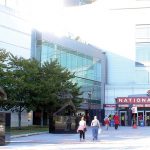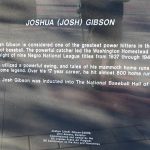
WASHINGTON, D.C.—When nearly 45,000 baseball fans embarked on Nationals Stadium for the 2018 Major League Baseball All-Star Game here in July, they likely noticed three statues dotting the entrance.
In addition to statues paying homage to Washington baseball legends Frank Howard and Walter “Big Train” Johnson, a bronze memento of Josh Gibson also lines the entry way.
The question that immediately arises is why Gibson, the legendary Negro League catcher from Pittsburgh’s Homestead Grays, is being lauded by a D.C. franchise, but the Pittsburgh Pirates currently do not have a statue in front of PNC Park paying homage to Gibson, a hometown hero?
“Josh Gibson actually played for the Washington Grays when the franchise moved from Homestead to D.C.,” explained Sean Gibson, Josh Gibson’s great-grandson, a Pittsburgh native and CEO of the Josh Gibson Foundation.
“They (Nats ownership) came to me to ask whether we’d be interested in erecting a statue in my great-grandfather’s likeness on Nats’ property.” Sean Gibson said it was a no-brainer, considering Josh played several seasons in D.C., and considered the nation’s capital his “second home,” where he and the Grays played their home games in Northwest D.C. at Griffith Stadium from 1940-1948. Annual football clashes between Howard University and Lincoln University also occurred at the stadium, which was located in a Black section of D.C., near the Howard University campus. The stadium was demolished in 1965. Today, Howard University Hospital sits on the former site, while a moniker denotes the once-thriving stadium’s former existence. The stadium was also home to the NFL’s Washington Redskins and the Washington Senators baseball team.
“I was fully aware of and involved in the entire process of having the statue in D.C.,” Sean Gibson told the New Pittsburgh Courier in an exclusive interview.
Meanwhile, it should be known that Josh Gibson was born in Buena Vista, Ga., and moved to Pittsburgh’s North Side at age 11. As a ball player, he lived in the Hill District’s “Sugartop” section, said Sean Gibson.
Notably, in 2005, the Pirates constructed what was then called Legacy Park in honor of Pittsburgh’s two successful Negro League franchises, the Homestead Grays and the Pittsburgh Crawfords, and their legendary owners and players. Statues and monikers of players such as Josh Gibson, Satchel Paige and James “Cool Papa” Bell were erected. But in 2015, Legacy Park was dismantled by Bucco ownership—providing Sean Gibson’s foundation with a chance to purchase the statues and ultimately auction them off for profit.
Retired Courier sportswriter Eddie Jefferies said he’s still disappointed with the Pirates’ decision to remove the statues.
“Upon learning that the Pirates had dismantled PNC Legacy Park I immediately harkened back to episodes in ‘Baseball’s Great Experiment’ (1983), where author Jules Tygiel alleges that the Pirates offered Negro League players tryouts at Forbes Field, opportunities that were subsequently and mysteriously cancelled,” said Jefferies.
Meanwhile, Rob Ruck, a University of Pittsburgh history professor and author of publications related to Negro League Baseball history, said he harbors mixed emotions concerning the removal of Legacy Park.
“Really, I was stunned when I heard the statues were gone,” he said, noting that the significant historical benefits that Legacy Park provided mainstream baseball fans, especially the youth, would be lost.
He continued by crediting Pirates ownership for their groundbreaking management decisions related to acknowledging the Negro League ball play.
“In the fall of 1988, the Pirates were the first Major League franchise to celebrate the Negro Leagues, with the 40th anniversary of the Homestead Grays Negro League Championship,” said Ruck. “The Pirates brought all the former ball players back to Three Rivers Stadium, and then-owner of the Pirates (Carl Barger) apologized for MLB’s overt racism in keeping Black ball players from joining the league. That was a groundbreaking move,” said Ruck, who’s authored “Sandlot Seasons,” an account of Pittsburgh’s rich sports history and the city’s impact on the development of the Negro Leagues.
He’s also the author of “Raceball: How the Major Leagues Colonized the Black and Latin Game.” In July he published “Tropic of Football,” a book paying homage to American Samoan athletes who find success in the NFL. Retired Steelers star Troy Polamalu, the late Junior Seau and quarterback Marcus Mariota are three such Samoan success stories.
In supporting the Pirates, Ruck states, “We shouldn’t be too hard on Bucco ownership. They put up banners at Three Rivers Stadium in honor of the Grays and the Crawfords. And they developed Legacy Park in honor of the Black players. They erected the statues and played videos to commemorate the great players. Yes, they really did a lot,” he said. “We have to give them credit for what they did.”
Ruck noted that the Heinz History Center provides a significant display paying homage to Pittsburgh’s professional Black baseball teams, in addition to the former Homestead High-Level Bridge. “The bridge has since been renamed the Homestead Grays Bridge, and there are historical markers on the bridge depicting several of the legendary players,” he said.
Ruck, 68, is a longtime Pittsburgh resident born in Iowa, but reared in Mount Lebanon. He also lived in Bloomfield, he said. As a University of Pitt student, he had a friend who lived in Homestead. Both were intrigued by steel mill activity occurring across the Monongahela River at Homestead’s U.S. Steel Works, which was easily observed from their Oakland dormitories.
“My buddy knew a little about the rich history of Homestead’s Black baseball legacy, but we couldn’t find much information when we started to research those facts. That intrigued me to learn more about those topics,” said Ruck.
People like Gus Greenlee (owner of the Crawfords) and Cumberland Posey (owner of the Grays) were names that began to surface, as Ruck’s research actions began to spread. He also speaks about the Black Fives pro basketball team and Black social club-sponsored baseball teams like the Monteciellos and the Loendis who were synonymous with Black Pittsburgh sporting success.
On July 12, a week before this year’s MLB All-Star Game, Sean Gibson was invited to Ben’s Chili Bowl restaurant in Northwest D.C. where a famous mural now includes his great-grandfather’s artistic image. The mural also includes President Barack Obama and Michelle Obama, Muhammad Ali, Dick Gregory, Prince and Go-Go musician and D.C. native, Chuck Brown. Bill Cosby was once featured on the eatery’s mural, but his image was removed in June 2017 amid his controversial legal issues.
Sean Gibson said he was more than ecstatic that MLB supported honoring the Grays and Josh Gibson’s legacy in the nation’s capital.
Ben’s Chili Bowl is a D.C. landmark known for its famous chili and beef/sausage hot dogs known as “half-smokes.” The restaurant is located on U Street and was founded in 1958 by Trinidadian native Ben Ali and his wife, Virginia. The business remains family-owned, although Mr. Ali died in June 2009.
Like us at https://www.facebook.com/pages/New-Pittsburgh-Courier/143866755628836?ref=hl
Follow @NewPghCourier on Twitter https://twitter.com/NewPghCourier


